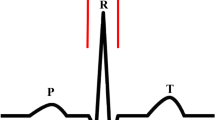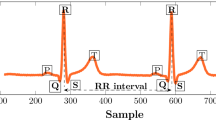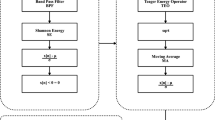Abstract
Accurate QRS detection is an important first step for almost every electrocardiogram (ECG) signal analysis. However, detecting QRS is difficult, not only because of the large variety, but also as a result of interference caused by various types of noise. This paper employs a hybrid feature extraction technique of ECG signal for the detection of cardiac abnormalities. Noise removal and accurate QRS detection play a major role in the analysis of ECG signals. In this paper various types of noises such as additive white Gaussian noise, baseline wander and power line interference is eliminated to enhance the signal quality. This study proposes an improved QRS complex detection algorithm based on the combination of empirical mode decomposition-discrete wavelet transform (EMD-DWT) with threshold and compared with ordinary discrete wavelet transform. The system efficacy and performance have been evaluated using accuracy, sensitivity (Se), positive predictive value (PPV) and detection error rate (DER). The results show the high accuracy of the proposed EMD-DWT algorithm, which attains a detection error rate of 1.1233%, a sensitivity of 99.28%, and a positive predictive value of 99.99%, evaluated using the MIT-BIH arrhythmia database. The proposed algorithm improves the accuracy of QRS detection compared to state-of-art methods.










Similar content being viewed by others
References
Abdalla FY, Wu L, Ullah H, Ren G, Noor A, Zhao Y (2019) ECG arrhythmia classification using artificial intelligence and nonlinear and nonstationary decomposition. Signal Image Video Process 13(7):1283–1291
Abo-Zahhad M, Ahmed SM, Abbas SN (2014) Biometric authentication based on PCG and ECG signals: present status and future directions. Signal Image Video Process 8(4):739–751
AlMahamdy M, Riley HB (2014) Performance study of different denoising methods for ECG signals. Proc Comput Sci 37:325–332
Anwar SM, Gul M, Majid M, Alnowami M (2018) Arrhythmia classification of ECG signals using hybrid features. Comput Math Methods Med 2018:1–8
Bagirathan A, Selvaraj J, Gurusamy A, Das H (2020) Recognition of positive and negative valence states in children with autism spectrum disorder (ASD) using discrete wavelet transform (DWT) analysis of electrocardiogram signals (ECG). J Ambient Intell Humaniz Comput. https://doi.org/10.1007/s12652-020-01985-1
Balouchestani M, Krishnan S (2016) Advanced K-means clustering algorithm for large ECG data sets based on a collaboration of compressed sensing theory and K-SVD approach. Signal Image Video Process 10(1):113–120
Cvetkovic D, Übeyli ED, Cosic I (2008) Wavelet transform feature extraction from human PPG, ECG, and EEG signal responses to ELF PEMF exposures: a pilot study. Dig Signal Process 18(5):861–874
El B’charri O, Latif R, Elmansouri K, Abenaou A, Jenkal W (2017) ECG signal performance de-noising assessment based on threshold tuning of dual-tree wavelet transform. Biomed Eng Online 16(1):1–18
Guven G, Gürkan H, Guz U (2018) Biometric identification using fingertip electrocardiogram signals. Signal Image Video Process 12(5):933–940
Kumar M, Pachori RB, Acharya UR (2018) Automated diagnosis of atrial fibrillation ECG signals using entropy features extracted from flexible analytic wavelet transform. Biocybern Biomed Eng 38(3):564–573
Lin HY, Liang SY, Ho YL, Lin YH, Ma HP (2014) Discrete-wavelet-transform-based noise removal and feature extraction for ECG signals. IRBM 35(6):351–361
Lin CC, Chang HY, Huang YH, Yeh CY (2019) A novel wavelet-based algorithm for detection of QRS complex. Appl Sci 9(10):2142:1-2142:19
Luz EJdS, Schwartz WR, Cámara-Chávez G, Menotti D (2016) ECG-based heartbeat classification for arrhythmia detection: a survey. Comput Methods Programs Biomed 127:144–164
Malleswari PN, Prasad S et al (2019) An investigation on the performance analysis of ECG signal denoising using digital filters and wavelet family. Int J Recent Technol Eng 8(1):166–171
Nishad A, Pachori RB, Acharya UR (2018) Application of TQWT based filter-bank for sleep apnea screening using ECG signals. J Ambient Intell Humaniz Comput. https://doi.org/10.1007/s12652-018-0867-3
NSVN RR, Rao M (2017) Optimal threshold estimation using cultural algorithm for EMD-DWT based ECG denoising. Sens Transducers 211(4):51–62
Pal S, Mitra M (2012) Empirical mode decomposition based ECG enhancement and QRS detection. Comput Biol Med 42(1):83–92
Patro KK, Kumar PR (2017) Effective feature extraction of ECG for biometric application. Proc Comput Sci 115:296–306
Pooja S, Gupta DV, Surender J (2019) ECG signal based arrhythmia detection system using an optimized hybrid classifier. Int J Innov Technol Explor Eng 8(9):2207–2212
Rai HM, Chatterjee K (2018) A unique feature extraction using MRDWT for automatic classification of abnormal heartbeat from ECG big data with multilayered probabilistic neural network classifier. Appl Soft Comput 72:596–608
Ramesh G, Satyanarayana D, Sailaja M (2020) Composite feature vector based cardiac arrhythmia classification using convolutional neural networks. J Ambient Intell Humaniz Comput. https://doi.org/10.1007/s12652-020-02259-6
Sahoo S, Biswal P, Das T, Sabut S (2016) De-noising of ECG signal and QRS detection using Hilbert transform and adaptive thresholding. Proc Technol 25:68–75
Shemi P, Shareena E (2016) Analysis of ECG signal denoising using discrete wavelet transform. In: 2016 IEEE international conference on engineering and technology (ICETECH), IEEE, pp 713–718
Singh R, Mehta R, Rajpal N (2018) Efficient wavelet families for ECG classification using neural classifiers. Proc Comput Sci 132:11–21
Wang Z, Zhu J, Yan T, Yang L (2019) A new modified wavelet-based ECG denoising. Comput Assist Surg 24(sup1):174–183
Zidelmal Z, Amirou A, Adnane M, Belouchrani A (2012) QRS detection based on wavelet coefficients. Comput Methods Programs Biomed 107(3):490–496
Author information
Authors and Affiliations
Corresponding author
Additional information
Publisher's Note
Springer Nature remains neutral with regard to jurisdictional claims in published maps and institutional affiliations.
Rights and permissions
About this article
Cite this article
Malleswari, P.N., Bindu, C.H. & Prasad, K.S. A hybrid EMD-DWT based algorithm for detection of QRS complex in electrocardiogram signal. J Ambient Intell Human Comput 13, 5819–5827 (2022). https://doi.org/10.1007/s12652-021-03268-9
Received:
Accepted:
Published:
Issue Date:
DOI: https://doi.org/10.1007/s12652-021-03268-9




